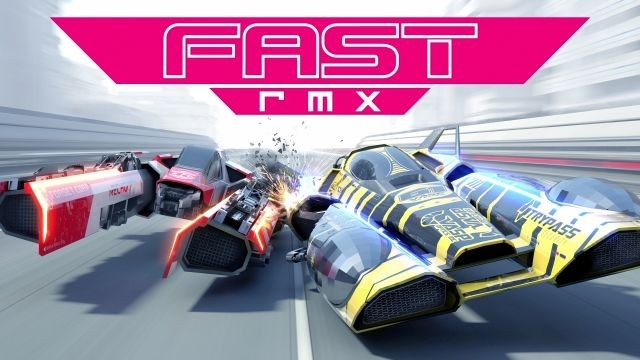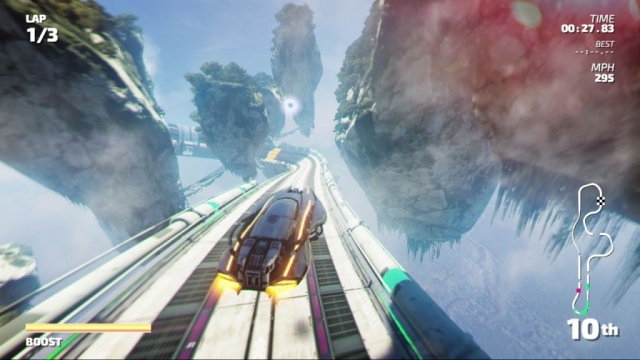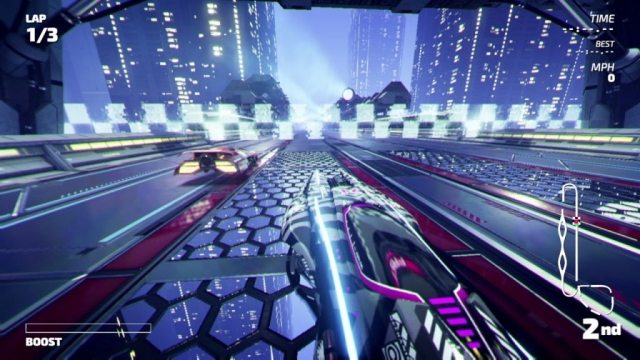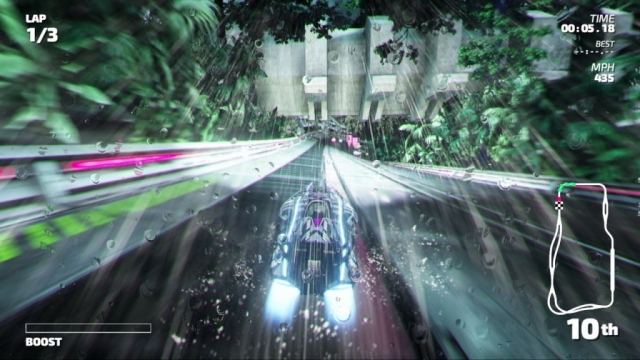Fast RMX

The Fast Racing series began as a true sleeper hit on the original Wii. The futuristic racer allowed fans of that sub-genre to enjoy the genre without having to dig out F-Zero GX, since Nintendo hasn’t done anything with the franchise since then. A sequel on the Wii U received a great deal of acclaim, and brought some of the best-looking graphics to the system. Fast Racing Neo also expanded on everything that worked in the original and offered up something that stood up nicely to the F-Zero and Wipeout franchises. The core game is very similar to what it was in Neo, but there’s more content here and there’s a significant increase in video qualtiy. The track design was exciting and the game blended in a bit of Ikaruga’s orange and blue power system to keep you on your toes at all times.
Other games, like Outland, have used this same system. Only here, instead of taking damage when you’re colored orange and going through a blue zone, you lose speed. This does far more harm to you than pure damage would in most racers, but does make you think your way through courses. It reminds me a lot of F-Zero 25 years ago, where you would have the bumpers on the side to ensure you didn’t go over a boundary – but you had to be mindful of your damage. Here, you have to make sure to keep things color-coded or you could wind up going from first to fifth in a heartbeat.
However, you can boost after grabbing orbs and those can save you. The boost pads throughout the track rely on you keeping things color-coded to gain anything, and you can use the manual boost to either save yourself from a mistake or need a Hail Mary play to win. Like F-Zero, you do have barricades to prevent you from going over the edge in regular play, but you can still go flying above things and wind up overshooting. Fortunately, you don’t have to worry about a game over state and can still catch up to some degree with boosting.
Being careful is key, and trial and error between the different crafts will allow you to find which ones you’re more comfortable with. I find myself enjoying things that had a good balance between handling and top speed, and didn’t worry as much about fast acceleration. That’s something you can always make up with either a boost or careful maneuvering. Thanks to spot-on controls, things feel far better now than they did on the Wii U’s gamepad. There, I did reasonably well – but not quite as well as now, where I can consistently get podium finishes.
Using the JoyCons either on the Switch itself or on the grip feels fantastic. The left stick’s rubberized coating allows you to get a better grip than other sticks, and the bumpers and triggers feel natural. Like F-Zero, using a trigger to lean right and left makes navigating windy areas a breeze. Here, you have far more hazards to work with though – like fan blades that make careful use of the leaning buttons a must to avoid being destroyed. The HD rumble adds a lot to the experience as a whole and when it comes to racing games, I haven’t been this impressed with the use of rumble since the PGR series.
There, racing on different surfaces led to different rumble effects – so racing on wood felt different than asphalt to some degree. Here, you’ll feel different rumble areas depending on where you collide – so being hit from the side leads to the side of the JoyCons rumbling, and depending on the level of the collision, it will affect just how powerful the effect is. This leads to each crash and collision feeling impactful beyond just the on-screen animation, which can sometimes hurt the immersion level due to clipping through the environment.
As a pure racing experience, Fast RMX succeeds where most non-Fast futuristic racers have failed. It provides a lot of thrills, but also features a fairly difficulty curve. The Wipeout series in particular just throws you into the thick of things without much of a chance for success – something that Redout is also guilty of. RMX gives you a fair chance in every race to not only succeed, but to win – and that’s with AI that will spin you out and go after you whenever they can. There’s an ever-present feeling of danger around not only every curve, but with every enemy interaction because being spun out will cost you precious time and you’ll need to make up for that quickly. This is especially true if it’s the final lap of a race, or worse, the final lap of a cup series race.
With online play on the Switch being free for early adopters for the time being, it feels great to play this online and experience anti-gravity racing with others. The bare-bones nature of things does hurt this aspect to some degree, but the high-quality and lag-free gameplay makes up for it. There is a bit of teleporting around that could be worked on, but for a wi-fi-only device like this, the online play is surprisingly well-crafted even if proper matchmaking is currently a bit lacking.
Visually, the game’s framerate is smooth and the graphics themselves never cease to be impressive. Much like F-Zero GX in 2004, you never wind up with a course that doesn’t dazzle you or end up with things getting too hectic to deal with. There’s a fine balance struck between chaos and beauty, and it results in one of the Switch’s best-looking experiences so far. With Redout also set for a release on the Switch, it could easily wind up being the console to own for anti-gravity racers – especially if an F-Zero game ever hits the device. The bump up in resolution is nice, resulting in crisper-looking assets while new lighting effects make lightning and fire stand out marvelously.
Like the F-Zero series, an intense countdown and announcer – using the same person, leads to some excitement right away. The music isn’t quite as catchy as that series, but remains a lot of fun to listen to. The sound design as a whole stands out thanks to the feeling of speed when you hit a boost pad, and the sound of losing power as you hit one with the wrong polarity. Crashes are loud and booming, but not distracting. The crowd’s excitement hypes you up slightly as well, but not to the degree that one might hope and it’s a bit odd to hear a crowd since no one is visible trackside.
Fast RMX doesn’t reinvent the series, but it does bring anti-gravity racing to a Nintendo console at launch for the first time in many years. It is a perfect pick-up for fans of the genre that grew up on F-Zero and wanted something to follow in its footsteps. It controls like a dream using the JoyCon grip and feels as natural as using a more traditional controller. It’s also one of the best-looking games on the system and takes what was already an incredible experience on the Wii U and improves it with more content. The online setup is flawed, but what little is there is executed well. Fast RMX is an outstanding game and one of the Switch’s best launch titles.
Reviewed By: Jeremy Peeples
Publisher: Shin’en Multimedia
Rating: 90%
——————————————————————————–
This review is based on a digital copy of Fast RMX for the Nintendo Switch purchased by the reviewer.
 Game Over Online
Game Over Online










